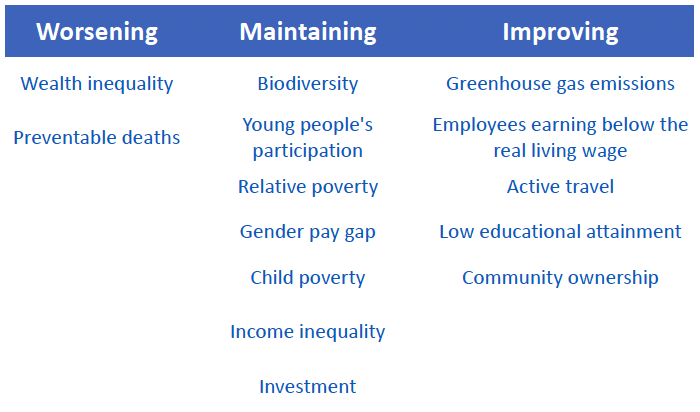Wellbeing economy monitor: December 2022 update
The monitor brings together a range of indicators to provide a baseline for assessing progress towards the development of a wellbeing economy in Scotland.
5. Summary of the data
The table below summarises progress with respect to the indicators. The Charts in detail section provides more information on performance against each of the indicators. Performance is assessed as improving, maintaining or worsening based on the change between the last two data points of an indicator. Details of the assessment criteria are provided in the Technical Annex. The assessment of performance is made objectively and impartially by senior analysts in the Scottish Government. Decisions on performance are made independently of Scottish Government Ministers.
Performance has been improving for five of the indicators, maintaining for seven and worsening for two.

Since the initial Wellbeing Economy Monitor was published in June 2022, new data has become available for four indicators: young people's participation; investment as a share of GDP; share of employees earning below the real living wage; and, assets in community ownership.
Young people's (16–19-year-old's) participation in education, training or employment increased from 92.2% in 2021 to 92.4% in 2022. This is the highest level ever reported and represents a continuation of longer-term trends. For this age group, between 2021 and 2022 participation in education fell from 74.8% to 73.1% and for training and development fell from 1.8% to 1.7%; however, participation in employment rose from 15.5% to 17.5%. Looking at longer-term trends, over the period 2018 to 2022 improvements in the overall rate of participation have mainly been driven by increased participation in education. Between 2018 and 2022 this rose by 1.8 percentage points, from 71.3% to 73.1%[5].
Investment as a share of GDP decreased from 17.1% in 2019 to 16.6% in 2020 and stayed at that level in 2021. This follows a fall from 17.4% in 2017 and 2018, which was the highest rate seen since 2007. Investment as a share of GDP has been persistently lower in Scotland than in most of our comparator countries. Scotland's business capital investment rates as a share of GDP are particularly low. However, Scotland performs comparably well in terms of public sector investment as a share of GDP when compared to other WEGo countries.
The share of employees earning less than the real living wage decreased from 14.5% in 2021 to 9.0% in 2022. This continues the downward trend seen since 2018. Between 2021 and 2022, the proportion of employees earning less than the real living wage decreased the most for employees in the Accommodation and food services sector (down from 68.0% in 2021 to 45.0% in 2022) followed by employees in the Wholesale and retail sector (down from 35.9% in 2021 to 20.4% in 2022).
The number of assets in community ownership increased from 663 in 2020 to 711 in 2021. Almost all of these assets are either land and/or buildings. The increase of 7% between 2020 and 2021 is in line with the steady upward trend in the number of assets owned since 2000. Of the 48 assets which came into community ownership in 2021, 27 were in remote rural areas, 6 in accessible rural areas, and 15 in urban areas[6].
Contact
Email: polly.legrand@gov.scot
There is a problem
Thanks for your feedback